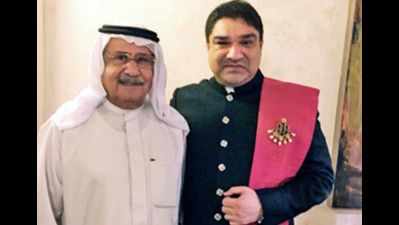- News
- City News
- ahmedabad News
- Bahrain honours India's textile heritage
Trending
This story is from December 25, 2015
Bahrain honours India's textile heritage
It was a rare honour for an Amdavadi when the Bahrain National Museum invited textile revivalist and designer, Umang Hutheesing, to put up an exhibition showcasing the grandeur and aesthetics of textiles and royal costumes from India.

It was a rare honour for an Amdavadi when the Bahrain National Museum invited textile revivalist and designer, Umang Hutheesing, to put up an exhibition showcasing the grandeur and aesthetics of textiles and royal costumes from India.
AHMEDABAD: It was a rare honour for an Amdavadi when the Bahrain National Museum invited textile revivalist and designer, Umang Hutheesing, to put up an exhibition showcasing the grandeur and aesthetics of textiles and royal costumes from India. The exhibition titled "The Magnificent Maharajahs: Splendour of Indian Royal Costumes" was inaugurated on December 21 by Queen Sabeeka bint Ibrahim Al Khalifa, wife of King Hamad, and president of the Supreme Council for Women.The exhibition will remain open for five months.
The exhibition has put on display 180 items. The exhibits are from the private collection of Deepak and Daksha Hutheesing. "The textile designs range from the eighth and twelfth century till the British period. So much of our textile heritage is getting lost in this era of fast-fashion that not many get the chan ce to step into the past and experinec real Indian craftsmanship which is so unique and shares so many common strains with textiles of Islamic countries. I was priviliged to be invited to the museum," said Hutheesing.
He further said that the exhibition exposed visitors from Oman, Saudi and Qatar to the rich textile heritage of our country. "It was a matter of pride or our ambassador and Bahrain's 30% Indian population that such an exhibition was put up at the Bahrain museum," said Hutheesing.
There are chogas (overcoats), abhas (worn by Kutch women), heavy zardozi work, chaniyas and other royal costumes on display. The exhibition is designed in such a way that it offers a social and historical context for the fabric on display.
The exhibition has put on display 180 items. The exhibits are from the private collection of Deepak and Daksha Hutheesing. "The textile designs range from the eighth and twelfth century till the British period. So much of our textile heritage is getting lost in this era of fast-fashion that not many get the chan ce to step into the past and experinec real Indian craftsmanship which is so unique and shares so many common strains with textiles of Islamic countries. I was priviliged to be invited to the museum," said Hutheesing.
He further said that the exhibition exposed visitors from Oman, Saudi and Qatar to the rich textile heritage of our country. "It was a matter of pride or our ambassador and Bahrain's 30% Indian population that such an exhibition was put up at the Bahrain museum," said Hutheesing.
There are chogas (overcoats), abhas (worn by Kutch women), heavy zardozi work, chaniyas and other royal costumes on display. The exhibition is designed in such a way that it offers a social and historical context for the fabric on display.
End of Article
FOLLOW US ON SOCIAL MEDIA










